Space systems of the US military communications: analysis of the state and development
The United States in recent years has justified its goals in space in many documents. The most significant of them are the US Space Command Plan for the period up to 2020 of the year (2002); “Space Doctrine” by President Obama (2010); “National Security Strategy in Outer Space”, prepared by the Ministry of Defense and the Directorate of National Intelligence (2010); “New US Military Space Strategy” (2011).
In 2010, the Joint Chiefs of Staff of the United States issued the concept of Joint Vision 2010 (the concept of "Full Spectrum of Dominance"). The central task of space activity in it is the achievement and strengthening of unconditional American military superiority and leading role in outer space.
Recently, there has been an active transformation of the methods of warfare, due primarily to the development of information technologies that have transformed the economic and social life of mankind. The nature of the war has changed radically and is reduced as a result to the postulate: everything that can be seen can be attacked, and that which can be attacked will be destroyed.
A new type of combat has arisen - information warfare, which also includes disabling enemy information systems.
A special feature of the US space strategy is its orientation towards the information component of the use of space, since it is information that greatly enhances the efficiency of other systems. The United States is gradually shifting its emphasis from strengthening combat power to the use of the information space and is seeking to dominate in this particular area.
Thus, the “New US Military Space Strategy” characterizes modern space as more and more crowded, competitive and complex. This document explicitly states that the US armed forces will take any active offensive measures to disinfect, disorganize, contain and destroy the enemy’s space infrastructure if it represents a threat to the US security.
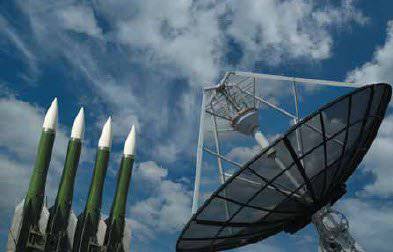 In turn, the Operational and Strategic Concept of the United States "Large-scale military operations" provides for the use of the armed forces of the United States and NATO, including in the form of a strategic aerospace operation (campaign).
In turn, the Operational and Strategic Concept of the United States "Large-scale military operations" provides for the use of the armed forces of the United States and NATO, including in the form of a strategic aerospace operation (campaign).It is with the aim of implementing the provisions of these documents that a global information and navigation system is created, which will be based on more than two hundred spacecraft. This system is already solving strategic and operational-tactical tasks in reconnaissance, troop control, and precision guidance. weapons and providing troops with communications anywhere in the world, and subsequently will be involved in ensuring the delivery of space strikes against ground targets.
In the coming years, the global information and navigation system may be supplemented with thousands of reconnaissance and attack unmanned aerial vehicles for various purposes and satellites - space inspectors. After integration with the global electronic intelligence system, the new supersystem will be fully capable of creating an effective global combat information field.
The contribution of satellite systems to solving reconnaissance, communication, radio navigation and meteorological tasks is constantly growing.
UNIFORM SYSTEM OF US MILITARY SATELLITE COMMUNICATION AND MANAGEMENT
Satellite communication systems play an important role in ensuring reliable control of the armed forces. The main purpose of satellite communications systems is to provide the governing bodies of the theater of operations or in a particular area with reliable, secure communication channels (data transmission) with groups of armed forces, tactical formations, individual military units and each soldier. The main qualities of satellite communications that other types of communications do not possess are global coverage and the ability to provide communication channels from anywhere in the world in a very short time.
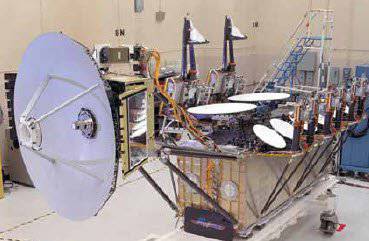 The AEHF system, after a full-scale deployment, should become one of the key links in the unified information system of global communications and management of state and military organizations and the basis of the space system for data exchange between combatants on land and at sea, in the air and in space.
The AEHF system, after a full-scale deployment, should become one of the key links in the unified information system of global communications and management of state and military organizations and the basis of the space system for data exchange between combatants on land and at sea, in the air and in space.The United States military satellite communications and control system also includes the military broadband satellite communications system (DSCS / WGS), the military narrowband satellite communications system (UFO / MUOS), the military space data relay system (SDS) from reconnaissance satellites and the military space system of the narrowband satellite communication (TacSat) for the Navy. Space-borne radar systems (Space Radar-SR) and unmanned aerial vehicles (UAVs), global positioning systems (GPS), space meteorological systems, satellite control systems, monitoring, communications, computer software, intelligence, tracking and surveillance (Command Control Communications Computers Intelligence Surveillance Reconnaissance, С4 ISR) for the situation on land, at sea, in the air and in space.
The military satellite communications systems of Great Britain (Sky Net) have found wide application in the unified information system of global communications and control of the USA France (Syracuze); Germany (SATCOMBw) and other US allies.
The United States military satellite communications and command and control system in peacetime and wartime attracts satellites of the global satellite relay system (TDRSS). Increasingly, the resources of commercial satellite communication systems Intelsat, SES, Eutelsat, Iridium, Globalstar, and others leased by the US Department of Defense are used as part of a unified system of military satellite communications and control.
US military satellite communications are the backbone of the armed forces information infrastructure and as of the beginning of 2013, they include the following systems: MILSTAR / AEHF, DSCS / WGS, UFO / MUOS, TacSat, and SDS.
SPACE SYSTEM PROTECTED COMMUNICATION MILSTAR / AEHF
The MILSTAR secure communications space system is designed to control the US strategic nuclear forces in a nuclear war. For this system, special measures were developed to ensure the autonomy and survivability of spacecraft.
For the purpose of high security of communication lines in the system, Ka-, K- and V-frequency bands are used. These frequency ranges make it possible to form narrow directional beams, which, along with the noise immunity of the channels, also increase the secrecy of communication lines, since the signals are difficult to pin down and, therefore, suppress. The use of special algorithms for coding and signal processing ensures a very high security of the communication channel. Intelligence and video information are transmitted through satellite technical means, voice exchange is carried out and video conferences are held.
The MILSTAR system is used not only for strategic nuclear forces, but also provides communication with all types and genera of US forces.
The orbital grouping of the system consists of five Milstar satellites (two Milstar-1 and three Milstar-2) in a geostationary orbit. The satellites were developed by Lockheed Martin.
The Milstar-1 satellites allow 192 low-speed (75 to 2400 bit / s) communication channel (44.5 GHz - uplink and 20.7 GHz - downlink) and cross-linking with each other at 60 GHz. In addition, the spacecraft has four UHF (300 and 250 MHz) communication channels of the AFSATCOM system for the USAF and one UHF (300 and 250 MHz) broadcast channel - for the US Navy.
The second-generation Milstar-2 satellites make it possible to organize 192 low-speed (from 75 to 2400 bps) and 32 medium-speed (from 4,8 kbit / s to 1,544 Mbit / s) protected communication channel in an extended frequency band.
MILSTAR system hardware implements the following functions:
• onboard processing and switching of signals;
• autonomous management of onboard resources;
• cross-use of the spectrum (receiving a signal through one antenna in one band and relaying it through another antenna in another band);
• inter-satellite communication.
The on-board antenna complex is capable of detecting the direction of active intentional interference and temporarily blocking or resetting the radiation pattern in the direction of interference, keeping the operation mode in other directions without loss of communication.
In the complex, the technical means of the system provide an adaptive reliable and stable secure connection between fixed, mobile and portable terminals. These technical means are mastered in commercial systems of personal satellite communications.
According to the plans, the operation of the MILSTAR system ends in 2014 year.
In turn, the replacement of the MILSTAR system of the millimeter-range AEHF space system provides a more secure (dual key), reliable, survivable and high-speed, compared to the MILSTAR system, global connection of the highest political and military leadership of the United States with the command of the armed forces, types and types troops, commanders of strategic and tactical groups of troops. The AEHF system is used in all theaters of war, on land, at sea, in the air, and in space under conditions of peace and war, including in conditions of nuclear war.
The AEHF system should consist of four (according to other data, of five) main and one backup satellite in geostationary orbit. The AEHF system is compatible with low-speed (from 75 to 2 400 bits / s) and medium-speed (from 4 800 bits / s to 1,544 Mbps) channels of the MILSTAR system, and also has new high-speed (up to 8.2 Mbps) communication channels.
The data exchange rate in the AEFH system is five times higher than the exchange rate in the MILSTAR system, which allows users to transmit real-time targeting and high-resolution video from unmanned aerial vehicles (UAVs) and remote sensing satellites.
Signal processing on board was added to the antenna complex with zeroing of the radiation pattern in the direction of interference (MILSTAR system). The latter provides protection and optimization of the onboard resources used, systemic flexibility with respect to various consumers in the types of armed forces and other users using land, sea and air-based terminals. In addition, the spacecraft of the AEHF system have a developed and reliable communication infrastructure between each other (each with two adjacent ones) in the millimeter (V-) frequency range (60 GHz).
The tactical and technical data of the MILSTAR and AEHF systems are presented in the 1 table.
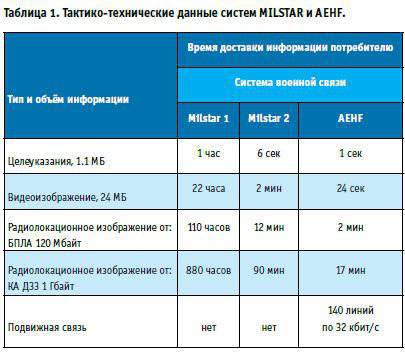
The AEHF system consists of three segments: space, user and ground. The space segment is an orbital grouping of spacecraft in a geostationary orbit with an inter-satellite communications system providing global coverage. The ground control segment of the system is designed to control devices in orbits, control their operational and technical state, and ensure the planning and management of a communication system. This segment is built according to the multiple reservation scheme and includes a set of fixed and mobile control stations. Ground-to-satellite links use the 44 GHz band, and satellite-to-ground channels use the 20 GHz band
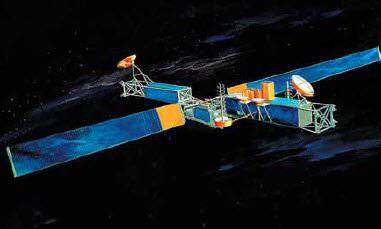 The AEFH spacecraft payload module includes an onboard signal processing and switching system that converts them from the 44 GHz band to the 20 GHz band and the antenna complex. On-board signal processing provides protection and optimization of on-board transponder resources, systemic flexibility with respect to system users using land, sea and airborne terminals.
The AEFH spacecraft payload module includes an onboard signal processing and switching system that converts them from the 44 GHz band to the 20 GHz band and the antenna complex. On-board signal processing provides protection and optimization of on-board transponder resources, systemic flexibility with respect to system users using land, sea and airborne terminals.The spacecraft antenna complex includes the following elements:
• global antenna;
• two transmitting phased antenna arrays (HEADLIGHTS) for working with portable terminals that form up to 24-x channels with time division;
• receiving antenna with PAR;
• six parabolic receiving and transmitting antennas on a gimbal suspension for the formation of regional rays;
• two highly directional antennas for tactical and strategic communications;
• two inter-satellite communication antennas.
Each satellite of the AEHF system, using a combination of HEADLIGHTS and parabolic antennas, forms the 194 regional beam.
Satellites are able to survive the use of nuclear weapons.
SPACE BROADBAND COMMUNICATION SYSTEM DSCS / WGS
The strategic communications system (Defense Satellite Communication System, DSCS) of the US armed forces provides communications for the highest military-political leadership, combined and special commands with unions, formations, units (up to the brigade level) and facilities of the armed forces of the United States troops. In addition, the system solves the problem of transmitting diplomatic, intelligence and government information, including the exchange of data between automated control systems at various levels and their elements.
The group includes eight satellites (six working spacecraft DSCS-3B and two in reserve) in geostationary orbit.
Spacecraft DSCS-3 series are provided with more reliable protection from electromagnetic radiation of a nuclear explosion than the spacecraft of the first two series, and have on board a broadband, interference-free communications equipment. In addition, they are equipped with a secure telemetry system and the reception and transmission of satellite control commands, which is designed for a quick restructuring in case of intentional interference. The capacity of a single spacecraft is from 100 to 900 Mbps.
The satellite payload module includes:
• six independent transponders and one single-channel transponder;
• three receiving antennas (two horns with a coverage area of the entire visible part of the Earth and one retargeted antenna);
• five transmit antennas (two horns with a coverage area of the entire visible part of the Earth, two retargeted antennas and one high gain parabolic antenna in a gimbal).
The payload module of satellites of this series operates in the X-band: 7900 – 8400 MHz to receive and 7250 – 7750 MHz to transmit. Power transponders - 50 watts. Channel bandwidth - from 50 to 85 MHz. To control the spacecraft and transmit telemetry used S-and X-bands.
Due to the increase in data traffic in the provision of backbone communications and new types of services for the armed forces in the Pacific, Atlantic, Indian Oceans and the continental US, the country's leadership in 2001 decided to develop a new national broadband satellite communications system (Wideband Global). Satcom, WGS). Therefore, the DSCS spacecraft are being replaced with WGS satellites, which will consist of six spacecraft.
WGS satellites are built on the basis of the Boeing BSS-702 platform of 13 kW and a lifetime of 14 years.
The launch of the first WGS satellite was made in 2007, two more in 2009, in January 2012 was launched WGS-4 satellite. The launch of the WGS-5 satellite is scheduled for the beginning of the 2013 of the year, and the WGS-6 is scheduled for the summer of the same year.
The payload module of the spacecraft WGS includes several dozen transponders and an antenna complex. The antenna complex can form 19 independent coverage areas and incorporates:
• X-band global antenna (8 / 7 GHz);
• transmitting and receiving phased antenna arrays that form coverage areas in the X-band 8;
• eight narrow-beam and two zonal parabolic transceiver antennas on a gimbal for forming 10 rays in the K- and Ka-bands (40 / 20 GHz and 30 / 20 GHz).
The 30 / 20 GHz band is designed for the Global Broadcast System (GBS) system. The global satellite broadband broadcasting system GBS transmits video, geodesic and cartographic information, as well as meteorological data and other information for formations, units of all types of US forces. The satellite receiving equipment of the GBS system operates in the Ka-band (30 GHz) and has four communication channels with a data transfer rate of 24 Mbps. Downlink data is transmitted in the Ka-band (20 GHz).
The capacity of the WGS spacecraft through the use of channel switching devices, means of frequency, spatial and polarization separation of signals and using GBS equipment ranges from 2.4 Gbit / s to 3.6 Gbit / s.
To control the target load of WGS satellites in the US armed forces, four Army Communications Control Centers have been created, each of which can simultaneously control the reception and transmission of data through three satellites.
The mission control center of satellites is one, its ground-based facilities operate in the S-band.
After the initial deployment of the WGS system and the launch of the first AEHF satellite, the US Department of Defense decided to shut down work on the Transformational Satellite Communications System (TSAT).
SPACE UFO BAND SATELLITE COMMUNICATION SYSTEM (MUOS)
The UFO satellite communication system (FLTSATCOM at the first stage) was created by the US Navy to provide communication between coastal centers and surface and underwater objects, aviation fleet and circular notification of fleet forces through a special channel. Currently, the UFO system is the main tactical mobile communications system of the US armed forces in the decimeter range. It is widely used by the Department of Defense, the Department of State, the President of the United States, and the strategic command to manage the operational and tactical units of all types of armed forces.
The working area of the system covers the continental US, Atlantic, Pacific and Indian oceans.
 At the beginning of 2013, the orbital grouping of the system included nine UFO spacecraft (eight main and one backup) in four orbital positions and X-NUMX of FLTSATCOM satellite in a geostationary orbit. UFO satellites are based on Boeing’s BSS-2 platform. The lifetime of the spacecraft is 601 years.
At the beginning of 2013, the orbital grouping of the system included nine UFO spacecraft (eight main and one backup) in four orbital positions and X-NUMX of FLTSATCOM satellite in a geostationary orbit. UFO satellites are based on Boeing’s BSS-2 platform. The lifetime of the spacecraft is 601 years. 11 solid-state UHF range amplifiers are installed on all spacecraft. They provide 39 communication channels with a total bandwidth of 555 kHz and 21 narrowband audio communication channel with a bandwidth of 5 kHz each, 17 relay channels with a bandwidth of 25 kHz and a channel of naval broadcasting with a bandwidth of 25 kHz.
The last three satellites of the UFO system are equipped with the GBS Global Broadcasting Equipment. These kits consist of 4-x 130 W transponders, operate in the Ka-band (30 / 20-GHz) and have a bandwidth of 24 Mbit / s. Thus, the GBS kit on one satellite provides 96 Mbps transmission.
A promising narrowband communication system (Mobile User Objective System, MUOS) is currently replacing the UFO system. The development and production of the satellite communication system MUOS is entrusted to Lockheed Martin. The MUOS system will include five satellites (one backup) in a geostationary orbit, a flight control center and a communications network control center. Each MUOS satellite has a capacity of eight UFO satellites.
The primary configuration of the communication system will include a ground control complex and two MUOS satellites, the first of which was launched on February 24 of the year 2012. The term of the deployment of the system of the first stage in full force - summer 2013 of the year.
MUOS satellites are based on Lockheed Martin’s A2100 platform. The lifetime of the spacecraft is 14 years.
The MUOS system is created using key technologies of civil satellite communications and significantly improves military communications capabilities, providing mobile users (from a strategic point to a separate infantryman) in real time with telephone, data and video services. The system is focused on the use of created joint user terminals of the Joint Tactical Radio Systems (JTRS) project compatible with the UFO system.
Satellites operate in the UHF, X and Ka bands. The system will provide narrowband military communications and data transmission at speeds up to 64 kbps. The overall speed of satellite communication channels is up to 5 Mbps, which is 10 times higher than that of the UFO system (up to 400 kbps).
The payload of the MUOS spacecraft allows more efficient use of the allocated frequency range, for which the system will be implemented multiple access with channel allocation on demand. Thanks to the use of modern methods of digital signal processing, new modulation methods and noise-resistant coding, the communication system will have higher reliability, security, noise immunity and efficiency of communication organization.
The most important requirements for a new system are: providing guaranteed access, communications in motion, the ability to form different networks and communications for their intended purpose and configuration, the combined interaction of communication networks of heterogeneous forces, global coverage, broadcasting mode and communications in polar regions, the ability to use small portable subscriber terminals.
SPACE NOSCOPIC SATELLITE COMMUNICATION SPACE US Navy TACSAT
In 2005, in order to make the military satellite narrowband communication system global, it was decided in the United States to create an experimental communication system on elliptical satellites.
In September, the experimental satellite TacSat-2011 was launched for this purpose 4. The spacecraft's orbit is elliptical with a perigee of 850 km, apogee of 12 thousand. 50 km, and an inclination of the orbit plane - 63,4 degrees. TacSat-4 is an experimental exploration and communications satellite designed by the US Navy Research Laboratory and the Applied Physics Laboratory at Johns Hopkins University with the participation of Boeing, General Dynamics and Raytheon. Weight - 460 kg, antenna diameter - 3,8 m.
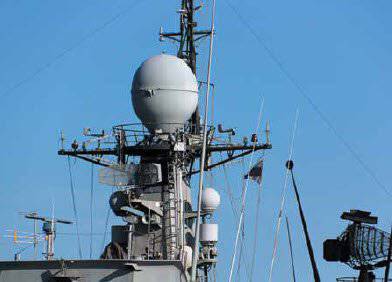 The purpose of the spacecraft: providing a global, protected, noise-resistant communications with units on the battlefield (communications on the go - communication on the move, COTM); detection of enemy submarines; bringing the results of the assessment of the situation and combat orders to the US Marine Corps and US Navy units in the face of strong opposition from enemy radio equipment.
The purpose of the spacecraft: providing a global, protected, noise-resistant communications with units on the battlefield (communications on the go - communication on the move, COTM); detection of enemy submarines; bringing the results of the assessment of the situation and combat orders to the US Marine Corps and US Navy units in the face of strong opposition from enemy radio equipment.The satellite provides up to 10 narrowband channels (2.4 to 16 kbps) in the UHF band (300 and 250 MHz).
The TacSat-4 satellite also has MUOS equipment with 5 MHz bandwidth for receiving and transmitting data via MUOS satellites to the GSO.
The testing and operation of the TacSat-4 spacecraft will allow the US Navy to determine the future need for satellites in high elliptical orbits operating in the system of geostationary satellites.
USE OF CIVIL COMMUNICATIONS SATELLITES FOR MILITARY PURPOSES
Today, the US armed forces, along with spending large amounts of money to build their own space communications systems, are more and more willing to use commercial satellites for communications and intelligence gathering. With the limited growth of military budgets and the ongoing global crisis, government and military structures of the United States and NATO countries are increasingly using the resources of commercial spacecraft, which are much cheaper than specialized military satellite communications systems.
The independence of the development of military and civilian space communications systems is largely artificial, since the main requirement defining their appearance is the possibility of their operation in outer space. A relatively recent understanding of the feasibility of creating dual-use space systems. Dual purpose involves the design of the system, taking into account its application to solve both civil and military tasks. According to experts, this contributes to cheaper production of spacecraft. In addition, the joint use of military and civilian satellite systems significantly increases the stability of communications in a theater of operations.
A vivid illustration of the influence of military structures on the use of commercial satellites during military conflicts is a well-known incident during the NATO-Yugoslav war. During the fighting at the end of 1990, the commercial satellite operator Eutelsat turned off the broadcast of the Yugoslav National Television via the HotBird satellites.
Similar shutdowns of national televisions of Libya and Syria were made by satellite operators Eutelsat (European operator), Intelsat (US operator) and Arabsat (followed by the states of Bahrain and Saudi Arabia).
In October 2012, satellite operators Eutelsat, Intelsat and Arabsat stopped broadcasting all Iranian satellite channels following a decision by the European Commission under economic sanctions. In October-November 2012 news Euronews channel programs broadcast via Eutelsat satellites were interfered.
In the United States, mechanisms have been developed for transmitting information received from military space systems to civilian authorities, as well as mechanisms for attracting civil and commercial space systems to solve military tasks. The US and NATO forces in Afghanistan and Iraq make extensive use of commercial satellite systems Iridium, Intelsat, Eutelsat, SES, and others. With the largest annual gradient (GAGR), among other applications, state (military) orders from Eutelsat continue to increase in recent years, which in 2011 amounted to 10% of the company's total revenues.
SES (Luxembourg) and Intelsat created separate units for dealing with military customers, and revenues from military orders in their total revenues in 2011 were 8% and 20% of their annual revenue, respectively.
Intelsat has invested in the creation of UFH-range payloads of Intelsat 14, Intelsat 22, Intelsat 27 and Intelsat 28 satellites. One of them (Intelsat 22) was created for the Australian Defense Ministry, and three more - for government, including the military, US organizations.
On the launch of the Intelsat 23 satellite, launched by 2009 in November on behalf of the United States Department of Defense, an Internet Router (Internet Router in Space, IRIS) was installed, physically combining the United States Department of Defense data networks. In March, the 14 of the year launched the Intelsat 2012 satellite, which, in the interests of the Australian Defense Ministry, included in the payload was 22 narrowband communication channels (18 kHz) in the UHF band (25 and 300 MHz). These channels will use the land, sea and air forces of Australia for mobile communications. The Australian Defense Ministry acquires the entire capacity of the UFH range and can use it at its discretion, including for sale to other consumers.
The Intelsat 27 spacecraft is scheduled for launch in 2013 and is being created by Boeing based on the BSS-702MP platform. On this satellite, in the interests of the US Department of Defense, the payload contains 20 narrowband channels (25 kHz) in the UHF band (300 and 250 MHz). The payload in the UHF band is similar to the payload of a military UFO-11 communications satellite and is designed to work in protected low-speed military communications systems such as UFO and MUOS.
In September, the first standardized additional payload for remote sensing of the Earth — the CHIRP (Commercially Hosted Infrared Payload) sensor — was put onboard the SES 2011 satellite of the SES satellite. CHIRP was commissioned by the United States Air Force to detect missile launches and installed by Orbital Sciences Corporation on the SES 2 satellite. Successful tests of CHIRP open up further prospects for the creation of a global operational Earth survey system based on small-sized payloads installed as a passing cargo onboard a spacecraft as part of global communication satellite systems.
Currently, SES is working with government and military structures of several countries around the world about using the company's satellite capacity in theaters of military operations and including additional payloads (connected and CHIRP) for military and special applications in the satellites under construction. The US government and the US Department of Defense in the next few years will remain one of the most important customers of SES.
European governments in the near future plan to significantly increase the use of SES spacecraft in the interests of organizing military and special communications to ensure the daily activities of military and other structures in areas of tension and military conflicts (Afghanistan, Iran, the Middle East, etc.).
Telesat is creating an Anik-G X-band payload in view of the future use of its capacity by the military.
Telesat and Intelsat companies are actively investing in the creation of payloads in the X, UHF and Ka bands, because these bands are most actively used by the military. This segment of the satellite services market is one of the fastest growing in the world. The United States, the countries of NATO and the countries of the allied alliance of international armed forces that perform military and peacekeeping tasks in Iraq, Afghanistan, North Africa and Asia actively rent the capacity of commercial (civilian) communications and broadcasting satellites to support peacekeeping operations and operations in theaters of military operations.
In addition, the demand for this type of service is triggered by the adoption of the doctrine, which involves the active use of video surveillance systems (space and ground) and unmanned aerial vehicles during operations of the armed forces.
In the United States, mechanisms have already been developed for transmitting to civilian authorities information received from military space systems, as well as mechanisms for attracting civil and commercial space systems to solve military tasks. The US Department of Defense receives a large amount of information from civilian remote sensing (Earth remote sensing) satellites, geodesy and meteorology.
The US military structures use more than 20% of the information obtained from the civilian remote sensing system of the United States, France and Japan.
The US Department of Defense Cartographic Office is the second after the Ministry of Agriculture agency for the number of purchased images received from the Earth remote sensing spacecraft. The interaction of the leading coordinators of the development of new technologies of military and civilian agencies (DARPA, NASA, etc.) in the form of joint projects and bilateral agreements on the coordination of work in the field of new technologies was also organized. The United States occupies a leading position in the use of military space systems for civilian purposes and commercial satellites for military purposes.
Recently, the tendency to use civilian (commercial) space systems for military purposes is increasing. For example, during the US military operation in Iraq and Afghanistan, up to 80% of military communications in the battlefield was provided by commercial satellite systems (Iridium, Intelsat, etc.). About a third of 30 thousands of projectiles and bombs fired on Iraq were controlled using the GPS satellite global positioning system.
Potential candidates for satellites - carriers of Earth remote sensing payloads are the spacecraft of the global mobile communications system IRIDIUM NEXT (launch of the spacecraft in 2014 year). The advantages of associated payloads - a radical reduction in their cost, even in comparison with small-sized devices.
The new trend took shape and organizational. In 2011, the United States formed the Hosted Payload Alliance (Associated Payload Alliance) - a non-profit organization that brings together developers, payload owners, and operators.
CONCLUSIONS
1. The US military satellite communications systems are combined into a single global satellite broadband broadcasting system GBS, transmitting all types of data and information for formations, units and military personnel of all types of armed forces. The GBS system implements a hierarchical addressing system with automatic address reconfiguration, as well as direct connections and connection of single user terminals such as JTRS.
2. In the near future, in the US military, any unit or unit, each member of the armed forces, or a piece of military equipment or weapons will have a unique address. This address will allow real-time monitoring of the position and condition of all elements of the situation - to form a single digital picture of the combat space with the necessary information security measures. In order to misinform the enemy, these addresses can be changed.
3.The US military is integrating satellite communications systems, a navigation satellite system, a geodetic satellite system, a space meteorological system, a rocket attack warning system, an Earth remote sensing system, and satellite and aviation reconnaissance systems into a single satellite network. The unified satellite network will include more than two hundred military, dual and civilian satellites attracted to support military operations in the theater of operations.
4. In conditions of limiting the growth of military budgets and the ongoing global crisis, government and military structures of the United States and NATO countries are increasingly using the resources of commercial spacecraft, which are much cheaper than specialized military satellite communications systems.
- Alexander Krylov, expert, director of the Space Communications Center "Skolkovo", a branch of the Federal State Unitary Enterprise "Space Communications", Ph.D.
- http://vestnik-glonass.ru/news/artcls/kosmicheskie_sistemy_voennoy_svyazi_ssha_analiz_sostoyaniya_i_razvitiya/
Information